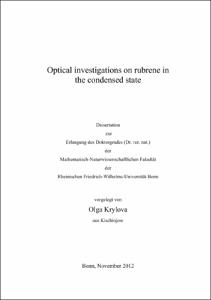Krylova, Olga: Optical investigations on rubrene in the condensed state. - Bonn, 2013. - Dissertation, Rheinische Friedrich-Wilhelms-Universität Bonn.
Online-Ausgabe in bonndoc: https://nbn-resolving.org/urn:nbn:de:hbz:5n-33040
Online-Ausgabe in bonndoc: https://nbn-resolving.org/urn:nbn:de:hbz:5n-33040
@phdthesis{handle:20.500.11811/5734,
urn: https://nbn-resolving.org/urn:nbn:de:hbz:5n-33040,
author = {{Olga Krylova}},
title = {Optical investigations on rubrene in the condensed state},
school = {Rheinische Friedrich-Wilhelms-Universität Bonn},
year = 2013,
month = aug,
note = {The incomplete understanding of the optical properties of rubrene, a material with a promising potential for future application in organic devices, inspired the present study. The main goal of the present investigations was the understanding of the optical excitation and relaxation mechanisms in rubrene (Rub) single crystals. A detailed analysis of the optical characteristics of Rub was carried out by using angle resolved absorption spectroscopy, excitation fluorescence spectroscopy, time-integrated / time-resolved fluorescence spectroscopy, and theoretical modelling. The fluorescence spectrum shows a strong reversible variation with temperature. The spectral changes are accompanied by a very strong (x 6 500) increase of the luminescence intensity at low temperatures. Time-resolved measurements show a strong (x 120) increase of the photoluminescence decay time upon cooling. A theoretical model of the excitation relaxation mechanism in Rub single crystal was proposed and used for the explanation of the experimentally observed temperature evolution of the photoluminescence spectra. The activation energies of non-radiative quenching mechanisms and radiative / non-radiative rates were estimated from fits to the experimental data by the proposed theoretical model. The experimental study in combination with the theoretical study of the optical spectra of Rub crystals yielded a picture that describes the excitation relaxation mechanism in Rub single crystal. This knowledge is important for the fundamental understanding of the complicated excitation and relaxation mechanisms in organic materials and could be hence usefully for optimisation of organic materials for optoelectronic applications.},
url = {https://hdl.handle.net/20.500.11811/5734}
}
urn: https://nbn-resolving.org/urn:nbn:de:hbz:5n-33040,
author = {{Olga Krylova}},
title = {Optical investigations on rubrene in the condensed state},
school = {Rheinische Friedrich-Wilhelms-Universität Bonn},
year = 2013,
month = aug,
note = {The incomplete understanding of the optical properties of rubrene, a material with a promising potential for future application in organic devices, inspired the present study. The main goal of the present investigations was the understanding of the optical excitation and relaxation mechanisms in rubrene (Rub) single crystals. A detailed analysis of the optical characteristics of Rub was carried out by using angle resolved absorption spectroscopy, excitation fluorescence spectroscopy, time-integrated / time-resolved fluorescence spectroscopy, and theoretical modelling. The fluorescence spectrum shows a strong reversible variation with temperature. The spectral changes are accompanied by a very strong (x 6 500) increase of the luminescence intensity at low temperatures. Time-resolved measurements show a strong (x 120) increase of the photoluminescence decay time upon cooling. A theoretical model of the excitation relaxation mechanism in Rub single crystal was proposed and used for the explanation of the experimentally observed temperature evolution of the photoluminescence spectra. The activation energies of non-radiative quenching mechanisms and radiative / non-radiative rates were estimated from fits to the experimental data by the proposed theoretical model. The experimental study in combination with the theoretical study of the optical spectra of Rub crystals yielded a picture that describes the excitation relaxation mechanism in Rub single crystal. This knowledge is important for the fundamental understanding of the complicated excitation and relaxation mechanisms in organic materials and could be hence usefully for optimisation of organic materials for optoelectronic applications.},
url = {https://hdl.handle.net/20.500.11811/5734}
}






